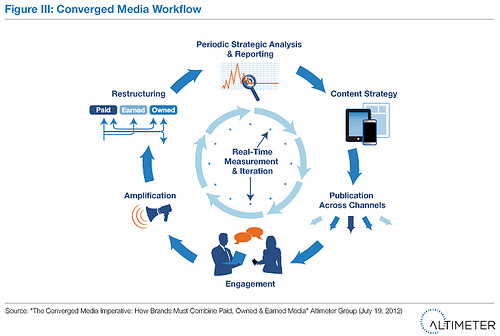
“I’ll check with my supervisor and get back to you.”
Why doesn’t that remark cut it anymore? More often than not, it’s symptomatic of an organization that isn’t adaptive. One that hasn’t taken advantage of new technologies, or empowered (or trained, or created policies around) the tools and technologies available to their employees. Tools their employees are very likely already versed in and using in their personal lives.
The adaptive organization is one of the themes I’m working on this year as a research analyst. Its ramifications directly target corporate leadership: CEOs, COOs, etc. Next in line is the marketing organization (and who hasn’t heard the refrain that today’s CMO may well be tomorrow’s CTO?).
Marketing organizations are currently siloed. There’s advertising, social, and communications. Digital may be walled off from traditional, content from display and broadcast. All these divisions function as fiefdoms, competing internally for budget and prominence. Within digital alone, there may be display, search, social, email and a long line of sundry et ceteras competing for a piece of the pie
Incentives to work cooperatively are often minimal at best within organizations. Small wonder brands have difficulties getting external agencies, vendors and marketing service providers to work in concert. These constituencies have business and revenue models even less conducive to opening kimonos than do internal staff.
Having just done a deep dive on how paid, earned and owned media are converging (The Converged Media Imperative), it’s become abundantly clear that organizations need to adapt – now – to flow learnings, functions, processes, creative and analytics across all three media channels while eliminating redundancies. Moreover, it’s increasingly necessary to do so with extremely agility; ideally, in real time or something very close to it.
Flowing paid, earned and owned media together is a team effort. Each channel is, on its own, highly specialized. Yet commingling these channels not only results in demonstrably better results for digital marketing initiatives. Converged media is also rapidly flowing out into the “real world” of traditional media as well as offline inevitably becomes more digital. Already we’re seeing examples of converged paid, owned and earned media occur on digital billboards and on television.
Some forward-thinking marketers are already erasing hierarchies between media types. Just weeks ago, Intel’s Nancy Bhagat blended the company’s global and social media teams into a single marketing strategy operation.
“Why does this make sense?,” asks Bhagat on her blog, “ I found we were having similar conversations across teams. The role of communities is not exclusive to the social space. Our paid media partners are looking for ways to drive engagement and conversation in ways previously unheard of. Our social partners are open in an exciting way to new product ideas and testing. The idea of ‘test and learn’ has never been so real.”
So real, or so difficult for enterprise organizations. Take content marketing, for example – or ‘owned’ media. Content is absolutely essential and central to paid, owned and earned initiatives. Without solid content, brands cannot achieve earned media at scale. Earned media amplifies messaging, builds word of mouth and buzz, spreads awareness, and with increasing frequency surfaces those ideas that become the core of creative advertising strategy.
Yet most organizations have yet to develop a plan or an organizational model to create, disseminate, publish, share and govern content. There’s general awareness that content strategy and marketing reside in the marketing org chart, but where? Just today, I spoke with an organization trying to unknot who is creating content where in the enterprise. Are efforts being reduplicated? Resources shared? Best practices and guidelines adhered to?
Their best detective efforts have thus far surfaced over 25 individuals in six distinct divisions who “do” content. It’s assumed very few of these people have met in person, much less collaborated. It’s assumed each group uses its own ad hoc software solutions for managing creation, workflow, resources, etc. Clearly, findings and insights are shared between these disparate content creators, much less their colleagues across the marketing organization.
Real time insights and optimization, and shared learnings that inform other initiatives (not to mention that can inform their own work) are an impossibility in vertically organized, hierarchical organizations. Enterprises must be able to move as quickly as their customers do. This requires bold realignment as well as informed empowerment.
